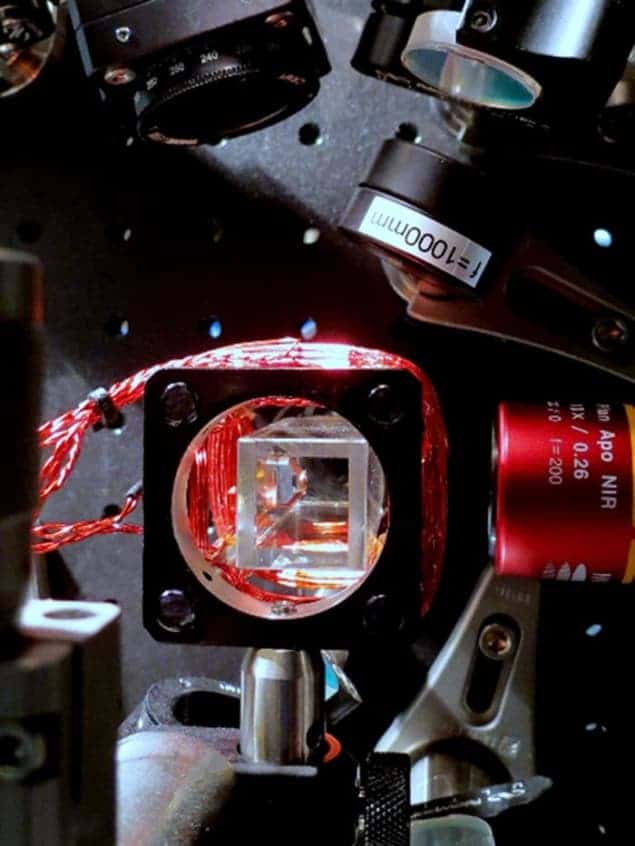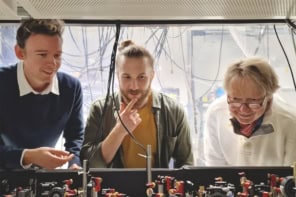
Physicists in the US say they are the first to directly observe single-atom interference over distances much greater than the atom’s coherence length. The experiment involves using optical tweezers and a sequence of laser pulses to “bounce” the atom along two different paths that meet up after about 1 ms. The team says that if the precision of the experiment can be improved, it could provide new information about the possible existence of non-Newtonian gravity at micron distances. The researchers say the technique could also be used to study the tiny force that arises between an atom and a conducting surface, dubbed the “Casimir–Polder effect”.
In the strange world of quantum mechanics, an atom can exist in a superposition of two or more trajectories until a measurement is made of its position or momentum. This property can be exploited in a matter–wave interferometer, whereby – strange though it may sound – a single atom can simultaneously follow two different paths to a detector. Forces on the atom will cause a relative phase shift between the two paths, resulting in a shift in an interference pattern created where the two paths meet.
Such experiments have been carried out before using large ensembles of atoms, effectively creating pulses of atoms that travel along each path. The atoms then create an interference pattern at the detector, which can be measured and used to infer the gravitational constant or to look for deviations from Newton’s theory of gravitation. Until now, however, it has not been possible to carry out matter–wave interference by sending just single atoms through the apparatus because most pulsed-interferometer experiments rely on high atomic throughput to boost the signal at the detector and therefore lack deterministic control at the single-atom level.
Controlling single atoms
The new, single-atom matter–wave technique has been developed by L Paul Parazzoli, Aaron Hankin and Grant Biedermann at Sandia National Laboratories in New Mexico. Their technique differs from earlier experiments in that each atom begins and ends its journey in optical tweezers – laser light that is focused to a small region in which the atom is held.
The Sandi researchers used a cloud of ultracold caesium atoms that are trapped and cooled to 4.2 μK using a combination of laser light and magnetic fields. They then created optical tweezers in the gas that can hold just one atom, before firing a laser pulse at the atom to place it in a specific quantum state. The optical tweezers were then switched off, letting the atom go into freefall.
Kicked up and down
The atom was then subjected to a sequence of light pulses separated by 500 μs. The first pulse puts the atom into a superposition of two states – one that has received an upward photon kick that causes it to rise up, and one that is falling because it has received no kick. The second pulse then either knocks the rising atom downwards or kicks the falling atom upwards – the result being two trajectories that will merge at a point in time 500 μs later where a third laser pulse causes their paths to overlap. When the states merge, the tweezers are switched back on and the quantum state of the atom is measured.
The entire process is then repeated hundreds of times to determine the phase shift between the two paths and thus the gravitational force on the atom at a level of 3 × 10–27 N.
Parazzoli, Hankin and Biedermann were able to see a clear interference pattern emerge when the relative phase of the pulsing lasers was adjusted, hallmarking the self-interference phenomenon of single atoms. In their experiments, the separation between the two atomic states was as large as 3.5 μm, which is more than 200 times greater than the coherence length of the atoms used. As a result, the team claims that its is the first demonstration of “free space” single-atom interference – with free space referring to the fact that the atom is unbound, allowing for its states to separate in space.
“Really cool”
Paul Hamilton of the University of California, Berkeley, who was not involved in the work, told physicsworld.com that the Sandia researchers “demonstrate full interferometry and show a very impressive long-term stability”. He also calls the experiment “a really cool textbook demonstration of single-atom interference”.
Because the technique employs one atom at a time, the Sandia team believes that it could be used to make extremely localized measurements of forces very near to surfaces, such as the Casimir–Polder force that occurs between an atom and a conducting surface. Like the more familiar Casimir force, this force arises from the zero-point energy of the vacuum and has implications for the design and operation of micron- and nanometre-sized mechanical devices.
The team also claims that if the sensitivity of the technique can be improved by two orders of magnitude, it could be used to place new constraints on theories of non-Newtonian gravity at micron-length scales. Indeed, if gravity is found not to be Newtonian at such tiny distances, it could provide important clues about how the theory of gravity could be unified with the Standard Model of particle physics. “This type of interferometer has shown absolute calibration in other cases, a characteristic that would be very useful for detecting departures from the inverse square law at micron-length scales,” says Parazzoli.
The research is described in a preprint on arXiv.



